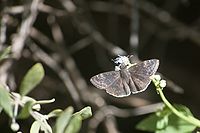en
names in breadcrumbs


Erynnis funeralis, commonly known as the funereal duskywing, is a species of butterfly of the family Hesperiidae. It is found from southern United States (California, Arizona, New Mexico and Texas), south to Argentina and Chile. Strays can be found north up to northern Illinois, north-eastern Nebraska, central Colorado, southern Nevada and central California.
The wingspan is 34–45 mm. They are very similar to the mournful duskywing, but can be distinguished by narrower fore wing with a light brown patch along outer edge. Their wings are black and brown with a white fringe on the hind wings. Adults are seen from February to October.[1]
The larvae have a black head and a green body with yellow hairs and yellow markings.[1] Its host plant is often Medicago sativa.[2] Larvae feed on various plants, including Robinia neomexicana, Medicago hispida, Lotus scoparius, Olneya tesota, Vicia, and Acmispon. Adults feed on flower nectar.[3][1]
Erynnis funeralis, commonly known as the funereal duskywing, is a species of butterfly of the family Hesperiidae. It is found from southern United States (California, Arizona, New Mexico and Texas), south to Argentina and Chile. Strays can be found north up to northern Illinois, north-eastern Nebraska, central Colorado, southern Nevada and central California.
 Funereal duskywing in Tucson, Arizona
Funereal duskywing in Tucson, Arizona The wingspan is 34–45 mm. They are very similar to the mournful duskywing, but can be distinguished by narrower fore wing with a light brown patch along outer edge. Their wings are black and brown with a white fringe on the hind wings. Adults are seen from February to October.
The larvae have a black head and a green body with yellow hairs and yellow markings. Its host plant is often Medicago sativa. Larvae feed on various plants, including Robinia neomexicana, Medicago hispida, Lotus scoparius, Olneya tesota, Vicia, and Acmispon. Adults feed on flower nectar.